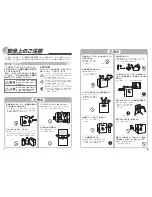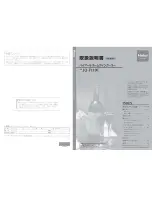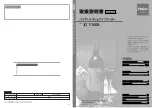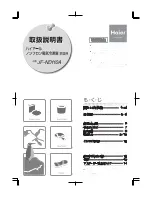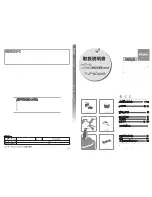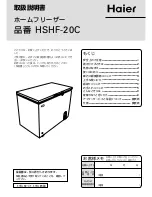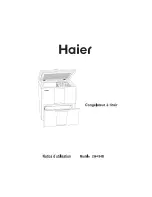
8
TROUBLESHOOTING GUIDE
You can solve many common freezer problems easily, saving you the cost of a possible
service call. Try the suggestions below to see if you can solve the problem before calling for
service.
PROBLEM
POSSIBLE CAUSE
Freezer does not operate.
Not plugged in.
The circuit breaker tripped or a blown fuse.
Compressor turns on and off frequently.
The room temperature is hotter than normal.
A large amount of food has been added to the
freezer.
The door is opened too often.
The door is not closed completely.
The temperature control is not set correctly.
The door gasket does not seal properly.
The freezer does not have the correct
clearances.
The freezer has recently been disconnected for a
period of time. 4 hours are required for the
freezer to cool down completely.
Temperature inside the freezer is too warm.
Temperature inside the freezer is too cold.
Popping or cracking sound when compressor
comes on.
Vibrations.
Temperature control is set too warm. Turn the
control to a cooler setting and allow several hours
for the temperature to stabilize. Door is kept open
too long or is opened too frequently. Warm air
enters the freezer every time the door is opened.
Open the door less often.
The door is not closed completely.
The door gasket does not seal properly.
A large amount of warm or hot food might have
been stored recently. Wait until the freezer has
had a chance to reach its selected temperature.
The freezer has recently been disconnected for a
period of time. 4 hours are required for the
freezer to cool down completely.
Temperature control is set too cold. Turn the
control to a warmer setting and allow several
hours for the temperature to stabilize.
Temperature of external freezer surface is warm. The exterior freezer walls can be as much as
30 F warmer than room temperature. This is
normal while the compressor works to transfer
heat from inside the freezer cabinet.
Metal parts undergo expansion and contraction,
as in hot water pipes. This is normal. Sound will
level off or disappear as freezer continues to run.
Bubbling or gurgling sound, like water boiling.
Refrigerant (used to cool freezer) is circulating
throughout the system. This is normal.
Check to assure that the freezer is on a level
surface.
Floor is uneven or weak. Freezer rocks on the
floor when it is moved slightly. Be sure floor can
adequately support freezer. Level the freezer by
putting wood or metal shims under part of the
3
IMPORTANT SAFETY INSTRUCTIONS
WARNING
To reduce the risk of fire, electrical shock, or
injury when using your freezer, follow these
basic precautions:
Read all instructions before using the freezer.
DANGER or WARNING:
Risk of child entrapment.
To avoid the possibility of child entrapment, please take the following precautions:
Never allow children to operate, play with, or crawl inside the freezer.
Before you throw away your old freezer:
Take off the door so that children may not easily
be entrapped.
It is dangerous to alter the specifications or attempt to modify this product in any way.
Never clean freezer parts with flammable fluids. The fumes can create a fire hazard or
explosion.
Do not store or use gasoline or any other flammable vapors and liquids in the vicinity of this
or any other freezer. The fumes can create a fire hazard or an explosion.
All freezer products contain refrigerants, which under the guidelines of federal law must
be removed before disposal. It is the consumer’s responsibility to comply with federal and
local regulations when disposing of this unit.
-Save these instructions-
INSTALLATION INSTRUCTIONS
Before Using Your Freezer
Remove the exterior and interior packing.
Check to be sure you have all of the following parts:
1 Instruction Manual
Before connecting the freezer to the power source, let it stand upright for approximately 4 hours.
This will reduce the possibility of a malfunction in the cooling system from improper handling
during transportation.
Clean the interior surface with lukewarm water using a soft cloth. (Cleaning instruction on page 6)
Installing Your Freezer
This appliance is designed to be free standing only, and should not be recessed or built-in.
Place your freezer on a floor that is strong enough to support the freezer when it is fully loaded.
Allow 5 inches of space between the back and sides of the freezer, which allows the proper air
ventilation. Adjust the feet to keep the freezer level.
Locate the freezer away from di rect sunlight and sources of heat (stove, heater, radiator, etc.).
Direct sunlight may affect the acrylic coating and heat sources may increase electrical
consumption. Ambient temperature below 50°F or above 85°F will hinder the performance of this
appliance.
This unit is not designed for use in a garage or any other outside installation.
Avoid locating the freezer in moist areas.
Plug the freezer into dedicated, properly installed-grounded wall outlet. Do not under any
circumstances cut or remove the third (ground) prong from the power cord. Any questions
concerning power and/or grounding should be directed toward a certified electrician or an
authorized service center.
This unit is not designed to be installed in an RV or used with an
inverter.
After plugging the appliance into a wall outlet, allow the unit to cool down for 2~3 hours under
before placing food in the freezer compartment.







